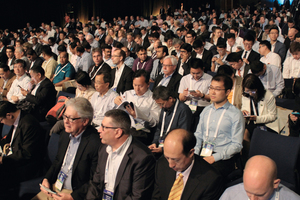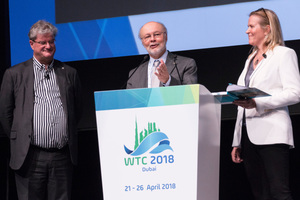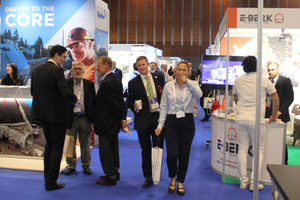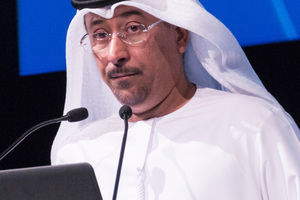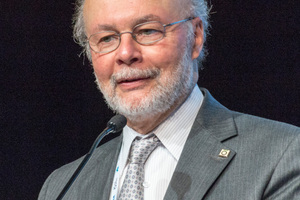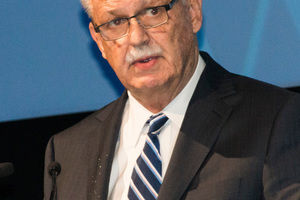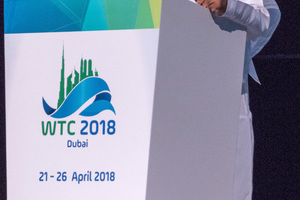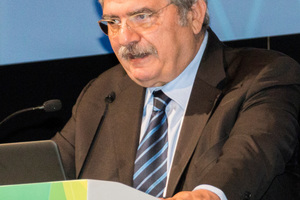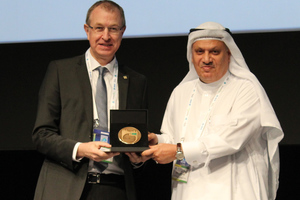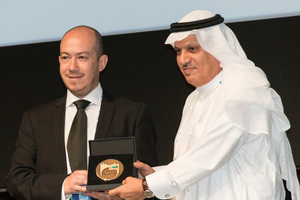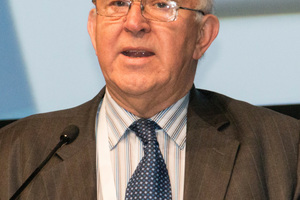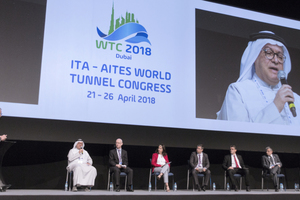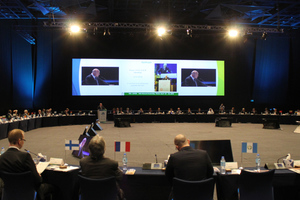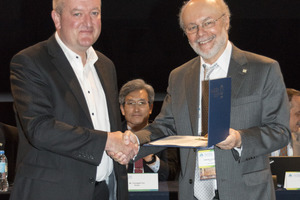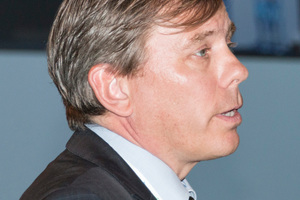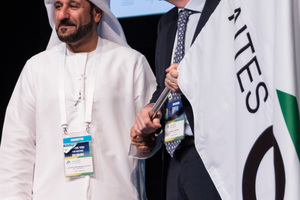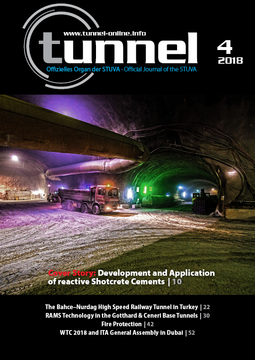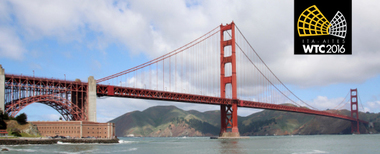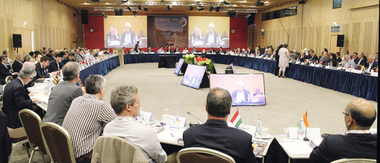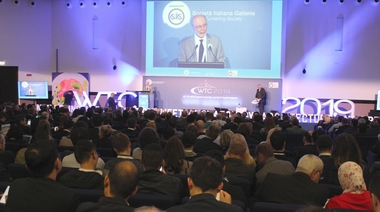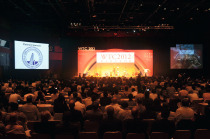ITA-Annual Meeting and World Tunnel Congress 2018 in Dubai
Around 1500 tunnellers from 68 countries met from 21 to 25 April, 2018 in Dubai, United Arab Emirates (UAE). The occasion was the 44th Annual Meeting of the ITA (International Tunnelling and Underground Space Association) in conjunction with the World Tunnel Congress (WTC) 2018.
The Tunnel Congress organised by the UAE tunnelling committee (Society of Engineers of United Arab Emirates, SOE UAE) in collaboration with the ITA was captioned “The Role of Underground Space in Building Future Sustainable Cities” (Fig. 1). 48 of the 75 ITA member countries were represented in Dubai. At 64 % the share of the countries represented was thus some 6 % lower than last year in Norway (see info box on p. 53).
1 World Tunnel Congress 2018
The main programme at the Congress embraced twelve thematic segments:
1 Projects in MENA and abroad
2. Advances in Materials
3. Safety in Design & Construction
4. TBM Case Studies
5. Smart Cities and Sustainability (ITACUS)
6. Contract Risks
7. Repair and Maintenance
8. Innovative Technologies (ITATECH)
9. Planning and Design
10. Construction Methods
11. Construction Risks
12. Fire Life Safety
The two committees ITA-TECH und ITACUS were seamlessly integrated in the WTC programme with blocks of their own. Thus, ITA-TECH dealt with innovative technologies in underground construction at its session. Under the title „Smart Cities and Sustainability“ ITACUS continued its ongoing deliberations on an urban future underground. In addition, in a separate presentation, the book produced by committee spearheads Han Admiraal und Antonia Cornaro „Underground Spaces Unveiled – Planning and Creating the Cities of the Future“ was introduced (Fig. 2).
The main programme’s 140
lectures were presented at four parallel sessions furthermore 210 poster presentations ran at the same time, in which
contributions were put across to interested parties through explaining a poster. The long versions of all lectures and poster presentations have been published in the digital proceedings of the World Tunnel Congress.
As in previous years, Committee and Working Group sessions took place in addition to “technical sessions”. Furthermore, on the Thursday following the Congress, a site field trip was available, ferrying those taking part to the “Route 2020” project. 130 companies displayed their products and services at the accompanying trade exhibition (Fig. 3).
ITA-Training Course
As in the past, a special ITA training course took place prior to the Congress – in the Congress Centre on 21 and 22 April, 2018. It was jointly organised by the UAE tunnelling committee, the Committee on Education and Training (ITACET) and the ITACET Foundation. This course aimed at young professionals was captioned “Main Opportunities and technical Issues in Tunnelling”. Unfortunately, only a total of 35 participants from 18 countries took advantage of the occasion to learn more about the available topics.
At the course, internationally recognised experts from the academic and business sectors elaborated on the different aspects of tunnelling in some 20 papers. Starting with an explanation of the advantages of underground facilities for urban areas, first of all, topics such as sustainability, ecological influences, economic development and social requirements were examined. Subsequently, the responsibilities of the main protagonists involved in planning, constructing and operating such facilities as well as legal aspects were dealt with. In addition to industrial safety, planning and design aspects, such as ground investigations, construction methods, anchoring, sealing as well as operational safety were featured.
Throughout the course, the participants took avail of the opportunity that was provided to throw questions at the experts.
Opening Ceremony
At the opening event on Monday, following some general remarks about Dubai, first of all Dawoud Al Hajri, General Director of the City of Dubai and President of the Society of Engineers (SOE, Fig. 4), as well as ITA President Tarcísio B. Celestino (Fig. 5) welcomed the participants. Then the hosts opened the exhibition together with the ITA Executive Council, as the SOE President was forced to leave the WTC early due to other commitments. The participants were requested to remain in the hall to view a new ITA film on tunnelling projects entitled “Tunnelling the World 2017” (also available from the ITA webpage). The “Cultural Performance” was dropped.
Then the ninth lecture commemorating Sir Alan Muir-Wood was held at this year’s WTC. In this „Muir-Wood Lecture“ Professor Dr. Edward J. Cording, Emeritus of the University of Illinois in Urbana-Champaign (USA, Fig. 6), examined “Monitoring and Controlling Ground Behavior at the Source – Recent Applications to Pressurized Tunneling”. The printed version of the lecture will soon be available for download from the ITA webpage. In this connection, it must be mentioned that Dr. Martin Herrenknecht, chairman of the board of the Herrenknecht AG from Schwanau (Germany), was chosen by the ITA Executive Council to present the next Muir-Wood-Lecture at the WTC 2019 in Naples.
During the further course of the opening ceremony, Sulaiman Al Hajri, Director of the Road and Transport Authority of Sharjah (Fig. 7), delivered a keynote speech on tunnelling in the United Arab Emirates. A further keynote address failed to materialise although listed in the programme. Then Professor Stefano de Caro, former Director-General of the International Centre for the Study of the Preservation and Restoration of Cultural Property (Fig. 8), delivered a cultural historical paper (known as the “Heritage Lecture”) on the Roman road network in Naples in general and historic underground structures in particular. This lecture was designed to inform those in attendance about the forthcoming WTC 2019 in Naples.
ITACET Foundation Awards
At the opening ceremony, the President of the ITACET Foundation Abdullah Al-Mogbel (United Arab Emirates), presented the ITACET Award 2018 to the former STUVA CEO, Prof. Dr.-Ing. Alfred Haack (Germany, Fig. 9). Haack was in this way honoured for his great involvement in further education as well as for his long-standing active support of the ITA and ITACET in particular. Back in 2000, during Haack’s own ITA presidency it was evident that the growing global requirement for well qualified engineers represented an ever-increasing challenge. It was Haack, who was responsible for introducing a special programme for training up-and-coming engineers at the ITA. Until this day, he has advised the ITACET Foundation, which was founded for this purpose, as an honorary member of the Committee of Surveyors.
A further ITACET Award went to the Chilean Tunnelling Committee (Comité de Tneles y Espacios Subterráneos de Chile). Giorgio Piaggio (Fig. 10), President of the CTES, accepted the prize, which honoured Chile’s special efforts to promote tunnelling. It represents recognition of the training courses to provide further training for engineers, which have been held regularly in recent years.
Open Session
At the start of the ITA Open Session on Tuesday, four new reports completed by the Working Groups during the past year were made public (Fig. 11):
Updated and expanded second version of the report originally published in 2014 “Guidelines for the Provision of Refuge Chambers in Tunnels under Construction” (WG 5)
Report on working under compressed air; third edition of the study last updated in 2015 “Guidelines for Good Working Practice in High Pressure Compressed Air” (WG 5)
Study on fibre-reinforced concrete segments “Guideline for Good Practice of Fibre Reinforced Precast Segments – Volume 2: Production Aspects”; the updated Volume 1 “Design Principles” was published at the WTC 2016 (ITA-Tech)
Guidelines on geophysical investigation and seismic methods “Geophysical Ahead Investigation Methods, Seismic Methods” (ITA-Tech)
This was followed by a panel discussion on “Contractual Practices of the 21st Century”. For this purpose, the organisers called upon persons from groups involved with underground construction projects, for instance representatives of owners, financial institutes, engineering offices, insurance companies and contractors (Fig. 12):
Dr. Amir Abdulgader, Saudi Ministry for Technical Affairs, Deputy Minister,
Patrick Bravery, chairman of ITIG (International Tunnelling Insurance Group), Liberty Specialty Markets,
Sofia Guerrero Gamez, Senior Transport Specialist at the World Bank,
Alexandre Gomes, Chief Technical Principal – Tunnels and Underground, SMEC,
Xavier Verdier, International Business Development Director Bouygues-Construction,
Rafaele Zurlo, Italian CEO of BBT The Brenner Base Tunnel,
Matthias Neuenschwander, head of ITA Working Group 3 “Contractual Practices”, Neuenschwander Consulting Engineers.
The occasion for the vigorous discussion was prompted by the fact that towards the end of the year, the “FIDIC Emerald Book” (Contractual Conditions for Tunnelling and Foundation Engineering Works) is to be published, which emerged from a joint study by the ITA and FIDIC (Federation of Consulting Engineers). This new contractual form deals with the special features and high risks of tunnelling, which clearly differ from civil and structural engineering. The Emerald Book’s most important aspects, which were also the object of the panel discussion, are:
Balanced sharing of the ground related risks between owners (ground conditions risks) /contractors (time and cost risks in the expected ground conditions)
Provisions for dealing with unforeseeable ground conditions will be included in the General Conditions of Contract
A provision for a standing Dispute Avoidance and Adjudication Board (DAAB)
A guidance for the preparation of tender documents
In summing up, the panel members concluded that the new contractual form can substantially improve cooperation among the parties involved in tunnelling.
2 General Assembly
President Tarcísio Celestino (Brazil) chaired the General Assembly (Fig. 13). To start with persons were remembered, who had passed away since the last Assembly and who had placed their stamp on both tunnelling and the ITA: Professor Zdzislaw T. (Richard) Bieniawski (Poland, USA, 1936-2017), Dr. Don U. Deere (USA, 1922–2018), Walter Grantz (USA, 1929–2018) and Prof. Dr. Franz Pacher (Austria, 1919–2018). Subsequently, Celestino informed the delegates about activities during the past year and the membership development. The number of member countries has risen by one to 75 since last year: New Zealand is the newcomer (Fig. 14). Although seven new corporate members and eleven individual members have joined in the meantime, the total number has not risen owing to cancellations and exclusions. Taking new registrations and resignations into consideration, the ITA now has 75 member countries, 173 corporate members (174 the previous year) and 93 individual members (previously 95). All in all, there has been a slight downwards trend as far as associated members (in other words, corporate and individual ones) are concerned – in contrast to member states – currently standing at 266 (269 last year and 271 the year before).
Last year, two new “Prime Sponsors” were acquired (VMT and CREG/Wirth); furthermore, five new “Supporters” were added. However, as eight Supporters broke off with the ITA, basically the balance remains the same. Altogether, 18 Prime Sponsors and 48 Supporters are involved with the ITA.
The ITA Executive Council put forward tasks and targets during the 2017 General Assembly in Bergen, which are intended to be achieved by 2020. They culminate in the leitmotiv “ITA, the leading international organisation promoting the use of tunnels and underground space through knowledge-sharing and application of technology”. The individual goals are:
1. Encourage Member Nations to develop activities, share knowledge, and promote underground space
2. Optimise the contribution of Working Groups and Committees
3. Enhance interaction with Industry
4. Encourage further knowledge sharing through education and training
5. Enhance tunnelling and underground space awareness
6. Improve communication with Member Nations, industry, and the general public
Further details on these targets were previously published in tunnel 7/2017 (p. 52 f.) and can also be downloaded from the ITA Website.
In order to achieve these goals, it was attempted to step up cooperation among the various groups under the slogan “3 Cs: Communication, Collaboration, Cooperation” during this year’s discussion involving the EC and the WGs. In this connection, it was discussed just what the main purpose of the WGs/Committees actually is, which improvements are needed in order to acquire members and what the ITA Secretariat and the Executive Council can do to provide support.
In order to keep the general public attuned to tunnelling, the ITA has presented annual prizes, known as the ITA Awards, in a number of categories for outstanding projects or developments since 2015. The latest presentation ceremony took place in 2017 within the scope of the AFTES Conference in Paris. The “ITA Tunnelling Awards 2018” will be presented from 5–7 November, 2018 in Chuzhou-Nanjing, China (further details under: awards.ita-aites.org).
In addition, the EC decided to form a “task force” to compile a data bank relating to accidents in tunnelling. The intention here is to learn from possible mistakes so that they can be avoided in future. In future, a special block during the WTCs will be devoted to this topic.
Partner Organisations
Additionally, contacts maintained by the ITA to various international sister organisations and UN organisations (see box on this page) were reported on. Arild Petter Søvik (Norway, Fig. 15) for example, reported on the activities determined by Committee D.5 “Road Tunnel Operations” for the current three-year period, which are of particular interest for underground facilities. This committee closely cooperates with ITA-COSUF. Thus, for example, a joint Conference on Safety in Road Tunnels will be organised at Lyon (France) from 3–5 October, 2018.
The publications produced by the PIARC Committee can be downloaded free-of-charge by accessing //www.piarc.org" target="_blank" >www.piarc.org:www.piarc.org; at present 38 reports on building and operating tunnels are available. An Online dictionary containing terms relating to road construction (and tunnelling) can also be found there.
Working Groups and Committees
The report on the work of the various Working Groups and Committees of the ITA took up a lot of time at the General Assembly, just as was the case in previous years. The Working Groups and Committees greatly contribute to the positive way in which the ITA presents itself to the world at large, as this is where people from different countries collaborate thus facilitating an important exchange of experience.
You will find an overview of the active Working Groups and the responsible contact person in the box on this page; a rundown of the Committees is to be found in the box on page 63. The ITA webpages provide you with details of the stage reached by their work and the activities they have planned for the months ahead for the WGs and the four Committees. The leaders of the WGs invite interested parties to take part in their work so that future ITA recommendations are enriched by their experience and knowledge. The heads of the Working Groups (as well as the German Tunnelling Committee office) will gladly respond to relevant queries.
Communication
The ITA has commissioned a press agency to improve communication. In addition, it regularly issues the E-Mail Newsletter “ita@news” free-of-charge. ITA members can also access the ITA scientific organ, the journal “Tunnelling and Underground Space Technology (TUST)”, in electronic form. Furthermore, the ITA-Website is also available as a source of information. It is intended on the one hand, for decision-makers as well as the general public and explains for instance, how underground spaces can be used and which construction methods are available. It cites specific advantages and provides information on planning, construction and operation. On the other hand, it gives details on how the ITA is set up, on member countries, corporate members, publications, the Committees and Working Groups as well as events featuring underground construction. Reports from the member countries dealing with their activities, which are made available every year, can also be accessed.
WTC 2019–2021
The General Assembly also had to decide on the venue for 2021. It was an easy decision as there was only a single candidate: Copenhagen (Denmark) was chosen accordingly. The dates and venues for the forthcoming Annual Meetings are:
3–9 May, 2019, 45th ITA Annual Meeting in Naples (Italy); the theme is: “Tunnels and Underground Cities: Engineering and Innovation meet Archaeology, Architecture and Art” (Fig. 16)
15–21 May, 2020, 46th ITA Annual Meeting in Kuala Lumpur (Malaysia); the theme is: “Innovation and sustainable Underground serving Global Connectivity”
14–20 May, 2021, 47th ITA Annual Meeting in Copenhagen (Denmark); the theme being: “Underground Solutions for a World in Change”
3 ITA Executive Council
No new members were elected to the Executive Council at this year’s General Assembly. Following the World Tunnel Congress 2018, Salma Saeed Almaamari (UAE) no longer belongs to the EC. EC member Lunardi will act as the contact person for the WTC 2019 in Italy. Teik Aun Ooi (Malaysia) will be available to the EC for the WTC 2020.
The ITA Executive Council is thus constituted as follows:
Tarcísio B. Celestino, Brazil, President till 2019
Søren Degn Eskesen, Denmark, Past-President till 2019
Alexandre Gomes, Chile, Vice-President till 2019
Ruth Gunlaug Haug, Norway, Vice-President till 2019
Eric Leca, France, First Vice-President till 2019
Jinxiu (Jenny) Yan, China, Vice-President till 2019
Davorin Kolić, Croatia (till 2019)
Giuseppe Lunardi, Italy (till 2019)
Chung-Sik Yoo, Korea (till 2019)
Lars Babendererde, Germany (till 2020)
Arnold Dix, Australia (till 2020)
Randy Essex, USA (till 2020)
Felix Amberg, Switzerland, Treasurer (till 2019)
Teik Aun Ooi, Malaysia (till 2020)
Finally, the internal auditor had to be elected. Really a formality, for as in previous years Sorin Calinescu (Romania) was available as the candidate. However, just prior to the vote, somewhat surprisingly, Rick Lovat (Canada) was put forward as a further candidate. Ultimately, however, Calinescu – in the second round of voting – was confirmed in office as internal auditor by the General Assembly for a further year by an absolute majority. In addition, since 1 January, 2009, Olivier Vion has been seconded to the Executive Council in his function of Executive Director.
The following responsibilities are defined within the Executive Council:
General Affairs: Jenny Yan
Development of the Working Groups: Alexandre Gomes
Development of the Committees: Ruth G. Haug
Development of the ITA Young Members: Alexandre Gomes and Ruth G. Haug
Industry Relations, Sponsorship: Eric Leca
ITACET Foundation: Tarcísio B. Celestino and Søren Degn Eskesen
The Executive Council is supported in its work by external experts:
Member Nation Development and Consolidation:
- Russia and the CIS Countries: Mikhail Belenkiy
- South-East Asia: Zaw Zaw Aye
Relations with World Bank: Harald Wagner
Representative of the Prime Sponsors, Industry Contacts and Sponsors: Peka Nieminen
Standardisation Work (Eurocode): Anna Lewandowska
4 Further Information
Further details on the World Tunnel Congress and the ITA Annual Meeting 2018 in Dubai as well as the most important resolutions adopted and the activities of the WGs and Committees can be found on the websites //www.ita-aites.org" target="_blank" >www.ita-aites.org:www.ita-aites.org, //www.ita-cosuf.org" target="_blank" >www.ita-cosuf.org:www.ita-cosuf.org,
//www.itacet.org" target="_blank" >www.itacet.org:www.itacet.org as well as in the digital proceedings of the World Tunnel Congress. Regular information on the ITA is supplied by the newsletter “ita@news” (can be subscribed free-of-charge via the webpage ww.ita-aites.org).
More details on the ITA and future ITA annual meetings are available from:
Secretariat of the German Tunnelling Committee (DAUB),
Mathias-Brüggen-Str. 41,
D-50827 Cologne
//www.daub-ita.de" target="_blank" >www.daub-ita.de:www.daub-ita.de
Secretariat of the ITA – International Tunnelling and Underground Space Association
MIE-IEH (International Environment House),
Chemin de Balexert 9,
CH-1219 Châtelaine, Geneva (new since 1.7.2017)
//www.ita-aites.org" target="_blank" >www.ita-aites.org:www.ita-aites.org
as well as the secretariats of the national tunnelling associations in the various ITA member nations.
ITA-Mitgliedsländer vertreten auf der Vollversammlung:
ITA Member Nations present or represented:
Argentina, Australia, Austria, Azerbaijan, Belgium, Bolivia, Brazil, Canada, Chile, China, Colombia, Croatia, Czech Republic, Denmark, Egypt, Ecuador, Finland, France, Germany, Greece, Hungary, India, Iran, Italy, Japan, Lesotho, Malaysia, Mexico, Nepal, New Zealand**, Nigeria, Norway, The Netherlands, Poland, Portugal, Republic of Korea, Romania, Russia, Singapore, Slovenia, Spain, Sweden, Switzerland, Thailand, Turkey, United Arab Emirates, United Kingdom, United States of America.
** neues Mitglied ab 2018/new member since 2018
ITA-Mitgliedsländer nicht vertreten auf der Vollversammlung:
ITA Member Nations not present:
Algeria, Belarus, Bhutan, Bosnia-Herzegovina, Bulgaria, Cambodia, Costa Rica, Guatemala, Indonesia, Iceland, Israel, Kazakhstan, Lao PDR, Macedonia (FYROM), Morocco, Montenegro, Myanmar, Panama, Peru, Qatar, Saudi Arabia, Serbia, South Africa, Slovakia, Ukraine, Venezuela, Vietnam.
Kontakte der ITA zu Schwesterorganisationen und UN-Organisationen
ITA Contacts with Sister Organisations and UN Organisations
ACUUS Associated Research Centers for the Urban Underground Space
FIDIC International Federation of Consulting Engineers
IAEG International Association for Engineering Geology and the Environment
ICLEI International Council for Local Environmental Initiatives
IFME International Federation of Municipal Engineering
IRF International Road Federation
ISOCARP International Society of City and Regional Planners
ISRM International Society for Rock Mechanics
ISSMGE International Society for Soil Mechanics and Geotechnical Engineering
ITIG International Tunnelling Insurance Group
PIARC World Road Association
UN-Habitat United Nations Human Settlements Programme
UN-ISDR United Nations International Strategy for Disaster
Reduction
Weltbank/World Bank
ITA Working Groups
Working Group 2: Research
Animateur: Elena Chiriotti (France); vice-animateur: Ron Tluczek
(South Africa); tutor: Chung-Sik Yoo (South Korea)
Working Group 3: Contractual Practices
Animateur: Matthias Neuenschwander(Switzerland); vice-animateur: Martin Smith (South Korea); tutor: Randall Essex (USA)
Working Group 5: Health and Safety in Works
Animateur: Donald Lamont (United Kingdom); vice-animateur:
Werner Burger (Germany); tutor: Ruth Gunlaug Haug (Norway)
Working Group 6: Maintenance and Repair
Animateur: Henry Russell (USA); vice-animateur: Paul Sparrow
(United Kingdom); tutor: Arnold Dix (Australia)
Working Group 9: Seismic Effects
Animateur: Giorgio Piaggio (Chile); vice-animateur: Wenge Qiu
(China); tutor: Daniele Peila (Italy)
Working Group 11: Immersed and Floating Tunnels
Animateur: Jonathan Baber (United Kingdom); vice-animateur:
Eelco van Putten (Netherlands); tutor: Davorin Kolić (Croatia)
Working Group 12: Sprayed Concrete Use
Animateur: Eivind Grøv (Norway); vice-animateur: Stefan Bernard (Australia); tutor: Giuseppe Lunardi (Italy)
Working Group 14: Mechanized Tunnelling
Animateur: Brian Fulcher (USA); vice-animateur: Karin Bäppler
(Germany); tutor: Søren Degn Eskesen (Denmark)
Working Group 15: Underground and Environment
Animateur: Cedric Thalmand (Switzerland); vice-animateur:
Nikolai Bobylev (Russia); tutor: Anna Lewandowska (Poland)
Working Group 17: Long Tunnels at Great Depth
Animateur: Gérard Seingre (Switzerland); vice-animateur:
Magali Schivre (France); tutor: Jinxiu “Jenny” Yan (China)
Working Group 19: Conventional Tunnelling
Animateur: Nasri Munfah (USA); vice-animateur: Robert Galler
(Austria); tutor: Alexander Gomes (Chile)
Working Group 20: Urban Problems, Underground Solutions
Animateur: Wout Broere (Netherlands); vice-animateur: Damian McGirr (United Kingdom); tutor: Olivier Vion (Switzerland)
Working Group 21: Life Cycle Asset Management
Animateur: Martin Muncke (Austria); vice-animateur: Laetitia d’Aloia-Schwartzentruber (France); tutor: Felix Amberg (Switzerland)
Working Group 22: Information Modelling in Tunnelling
Animateur: Jurij Karlovsek (Australia); vice-animateur: Paolo Cucino (Italy); tutor: Lars Babendererde (Germany)
ITA Committees and Young Members
ITA-CET – Committee on Education and Training
Animateur: Robert Galler (Austria); vice-animateur: Michel Deffayet (France); tutor: Eric Leca (France)
ITACET Foundation
Chairman of the Foundation Council: Abdullah Al-Mogbel (Saudi-Arabia) and Piergiorgio Grasso (deputy; Italy); Executive Board: Robert Galler (President; Austria), Michel Deffayet (Technical Director; France) and Claude Berenguier (Executive Director; France)
ITA-COSUF – Committee on Operational Safety of Underground Facilities
Animateur: Max Wietek (Austria); vice-animateur: Eric Premat (France); Tutor: Felix Amberg (Switzerland)
ITACUS – Committee on Underground Space
Animateur: Han Admiraal (Netherlands); vice-animateur: Antonia Cornaro (Switzerland); tutor: Chung-Sik Yoo (South Korea)
ITA-TECH – Committee on Technologies
Animateur: Nick Chittenden (United Arab Emirates); tutor: Søren Degn Eskesen (Denmark)
ITAYM – Young Members Group
Animateur: Keith Bannerman(Australia); vice-animateur: Jasmin Amberg (Switzerland); tutor: Alexandre Gomes (Chile) and Ruth Gunlaug Haug (Norway)

